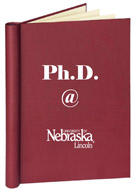Graduate Studies, UNL

Dissertations and Doctoral Documents, University of Nebraska-Lincoln, 2023–
First Advisor
Eric A. Weaver
Degree Name
Doctor of Philosophy (Ph.D.)
Department
Biological Sciences
Date of this Version
7-2024
Document Type
Dissertation
Citation
A dissertation presented to the faculty of the Graduate College of the University of Nebraska in partial fulfillment of requirements for the degree of Doctor of Philosophy
Major: Biological Sciences (Genetics, Cellular, and Molecular Biology)
Under the supervision of Professor Eric A. Weaver
Lincoln, Nebraska, July 2024
Abstract
Swine Influenza A Virus (IAV-S) imposes a significant burden on the pork industry and poses a great threat to public health due to its zoonotic potential. Susceptibility to human, avian, and swine influenza make pigs the ultimate mixing vessels for reassorted influenza A virus strains. Current vaccination strategies induce short-lived and strain-specific responses against IAV-S. Further, the substantial genetic diversity of IAV-S necessitates consistent revaccination and updating of commercial vaccines. Computational platforms have recently emerged as a promising strategy to develop new-age vaccines against infectious diseases in livestock animals. Here, we describe a computationally derived set of vaccine immunogens, called the Epigraph, that maximize incorporation of potential B and T cell epitopes (PBTEs) into the immunogen design. We use a recombinant human adenovirus type 5 (HAdV-5) vaccine platform to deliver the Epigraph immunogens. Our initial studies targeted H1 IAV-S and assessed the protective efficacy of the Epigraph immunogens compared to wildtype (WT) sequences delivered by the same adenoviral vector. These responses were compared to a commonly used commercial comparator vaccine, FluSure XP. We observed that the Epigraph immunogens induced significantly better protective immunity in both mice and swine. Given the success of the Epigraph immunogens, we further assessed the onset and duration of immunity in the first longitudinal study in swine, and observed rapidly onset antibody and T cell responses that significantly outperformed the FluSure XP vaccine. These responses remained protective for 6 months after the initial vaccination and protected against heterologous IAV-S challenge. Finally, to further assessed the breadth of immunity provided by the Epigraph vaccine, we performed dose-sparing studies and determine the minimum dose required to maintain protective immunity against highly divergent H3 IAV-S. Taken together, our data indicates that the Epigraph immunogens provide superior immunity compared to WT immunogens, rapidly induces robust and durable immunity in swine, and can protect at increasingly lower doses in swine. These data indicate that the Epigraph strategy may be useful in developing a universal and broadly protective vaccine against IAV-S.
Advisor: Eric A. Weaver
Recommended Citation
Petro-Turnquist, Erika, "Development of a Durable and Low-dose Universal Vaccine Against Swine Influenza A Virus" (2024). Dissertations and Doctoral Documents, University of Nebraska-Lincoln, 2023–. 177.
https://digitalcommons.unl.edu/dissunl/177
Included in
Allergy and Immunology Commons, Meat Science Commons, Therapeutics Commons, Virus Diseases Commons


Comments
Copyright 2024, Erika Petro-Turnquist. Used by permission